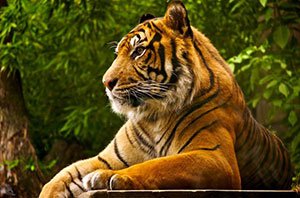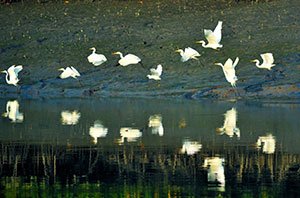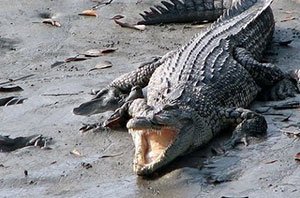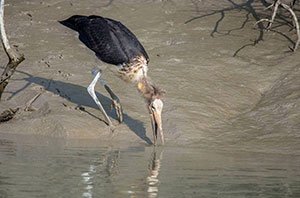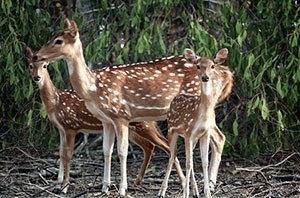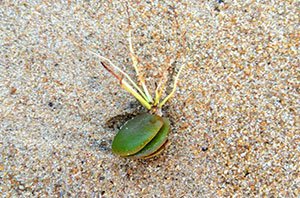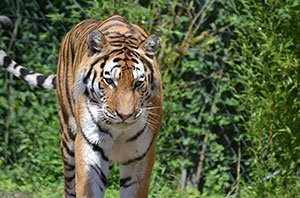Sundarban Tourism



Sundarbans National Park
The Most Famous Tiger Zone in the World’s Largest Mangrove Forest in India
The Sundarban National Park is a tiger and biosphere reserve located in the Sundarban delta in the state of West Bengal (India). The Sundarban is named after the Sundari trees which are found in bulk in this area. The park was established as a national park on 4th May 1984 as earlier it was created as a wildlife sanctuary in 1977, designated as the core area of Sundarban Tiger Reserve.
Welcome to the land of tigers called “The Sundarban National Park” extends in an area of approximately 1,355 Kms. The best referred time to visit this park is in the time between September and May. If you visit in wintry months you could see the sun-bathing crocodiles on the river banks as well as you may get to see amazing and powerful Royal Bengal Tigers. Apart from Bengal Tiger other chief wildlife species, you may get a glimpse in this park are Macaques, Indian Grey Mongoose, Leopard Cats, Ridley Sea Turtle, Wild Boar, Jungle Cat, Fox, Flying Fox, Fishing Cats, Chital, Pangolin and a lot other wild birds and animals.
Exotic package of Sundarban is a lifetime experience as it is a place that is completely clad in incredible natural beauty and exclusive mangrove habitat: the unique flora and fauna will surely let you feel the exquisite beauty, wilderness, and exotic beauty of nature during the Sundarban Day Tour.
Ample of things are there to make your Sunderban tour memorable. Gliding crosswise the river in the boats takes you to the proximity of wildlife. Although completely unpredictable, you may see varied cultural adventures and a close encounter with the tigers which will build dome never-to-forget memories for you. The serene ambiance and relaxed halo equip you with new energy, zeal, and enthusiasm that will make you a happy soul for Sunderban Tourism. Away from the hustle and bustle of the city, your mind and soul rests here in the lap of Mother Nature. You will enjoy your encounter with the vibrant bees: your sensory organs will feel delighted with the chirping of birds, and the new sensations of delight will take you to the unique natural realm of rejuvenation.
Best Time for Sundarban Tourism
Visiting Sundarban during winter (October to March)
It is the best time to visit the Sundarban due to the pleasant weather from October to March. Except for a few days of winter, the entire duration of the above time will offer you lovely weather with a moderate climate. The temperature will remain between 10 to 30 degrees Celsius. You will enjoy the flora and fauna of the Sundarban and the beauty of the raw forest without any hassle, tussle, and trouble in your winter package of Sundarban Tour.
How to Reach Sundarban
- By Air
- By Train
The nearest major railway station is the Sealdah Railway Station and the nearest local railway station is Canning Railway Station. The Sealdah Railway Station is one of the prime Railway Junctions in West Bengal Sunderban Tour and is located on the main route of the northeast railway zone and connected to the various cities of India by the regular trains. So, you can visit the Sealdah railway junction from other corners of India and then reach the Canning railway station by using the local trains from Sealdah, which will take around one and a half-hour of the train ride. Further, you can take the private taxi or shared public transport at the Canning to reach the entry point of Sundarban at Godkhali to board the boat for the safari.
- By Road
The Sundarban visitors, who want to travel by road, can either take the public transport from Kolkata to Canning and further Canning to Godkhali or hire the private taxi or cab to reach directly to Godkhali from Kolkata for Sundarban National Park tour. It is better to hire a cab or a taxi as public transport mat seen to you unmanageable and overcrowded crowded. The road distance from Kolkata to Godkhali and Canning is around 120 km and 64 km, respectively. At Sundarban Tour from Godhkhali, , you can get into the boat to further explore the forest.
Flora and Fauna of Sundarban
Major Flora
- There are 64 plant species in Sundarban and they can withstand estuarine conditions and saline inundation on account of tidal effects. The most common species are : Hatal (Phoenix paludosa), Genwa (Excoecaria agallocha), Dhundul (Xylocarpus granatum), Kankra (Bruguirea gymnorrhiza), Champa(Bruguiera parviflora), Dhani ghas (Porteresia coarctata), Garjan (Rhizophora apiculata), Keora (Sonneratia apelata), Sundari tree (Heritiera fomes), Golpati(Nypa frutcans). Sundarban tourism allows you to see all these species of plant.
Main Species
- Excaecaria sp., Heritiera sp., Ceriops sp., Phoenix sp., Sonneratia sp., Avicennia sp., Rhizophora sp., Xylocarpus sp., Bruguiera sp. etc.
Major Fauna
- Tiger, fishing cat, chital, wild boar, water monitor, estuarine crocodile.
Endangered Species
- Tiger, Estuarian Crocodile, River Terrapin (Batagur Baska), Olive Ridley Turtle, Gangetic Dolphin, Ground Turtle, Hawks Bill Turtle, King Crabs (Horseshoe).
